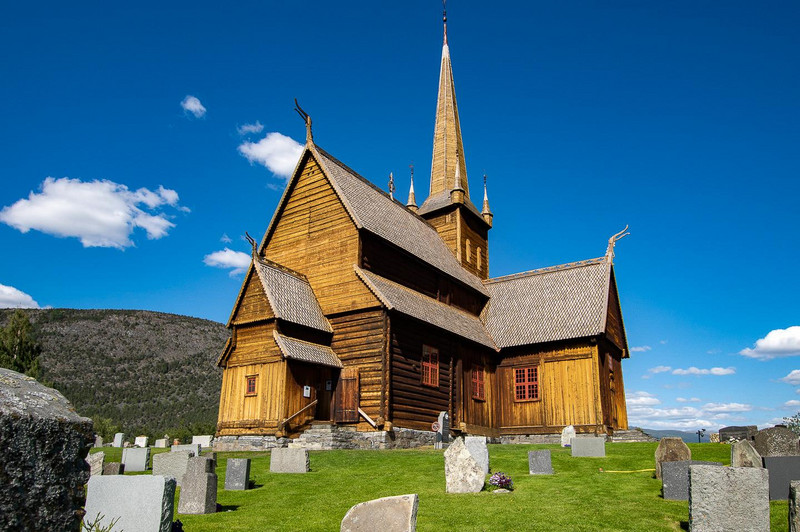Norway is an absolute dream country for road trips! Narrow roads with little traffic, lots of spectacular hairpin bends and breathtaking landscapes - here you can experience fantastic natural phenomena such as glaciers, fjords, raging rivers, waterfalls and mighty rock formations up close. A hike to the imposing Preikestolen rock pedestal, a visit to the colourful wooden houses in Bergen and the village of Geiranger and its fjord of the same name are not to be missed, nor are impressive animal observations on the bird island Runde and in Dovrefjell National Park. The hairpin bends on Trollstigen round off the road trip to an incomparable travel experience.
It is hardly possible to describe Fjord Norway, you have to experience it. Blue fjord beauties where glaciers push into the valley, crystal-clear water and mountains that grow into the sky. The region is above all one thing: a feeling. The feeling of being small and overwhelmed in the midst of untouched nature. Come with us to Fjord Norway and experience the region individually and intensively with a camper. Thanks to the Everyman's Right, you can stay overnight almost anywhere. If you long for a warm shower or need electricity, you can stay at one of the countless campsites, which are usually well equipped.
My money-saving tip: Rent your motorhome while you're still in northern Germany. You can reach Norway's capital Oslo in two to three days without rushing - either via the Danish Vogelfluglinie and western Sweden or directly by ferry from Kiel to the Norwegian capital in a good 20 hours.
You can see the most important sights of Oslo in one day. For example, visit the Opera House, the city's new landmark. It is not only the most spectacular building in Oslo, it is also one of the most extraordinary opera houses in the world. It was completed in April 2008 to a design by Snøhetta. Or stroll along the boulevard Karl Johans Gate, where the most important representative and historic buildings are located: the Cathedral Church, the University, the Parliament Building and the National Theatre. The end of the street is the handsome Royal Castle, where you can watch the changing of the guard in the afternoon. As befits a promenade, you will also find international restaurant chains, souvenir shops and boutiques here.


After a long day in Oslo, we head out into nature and north to Lillehammer, probably Norway's most sporty town. In addition to the Olympic sites including the large ski jump and the Olympic Museum, which beautifully documents the 1994 Games, the small town offers an idyllic shopping street and a nice city park with a good park café. In the amusement park "Lilleputthammer", small as well as big "children" enjoy the many rides and activities. But you shouldn't miss the delightful Det Lille Pannekakehuset. It's a great place to start the day with coffee and pancakes.
On the way to Dombås, it is worth stopping in Ringebu. Visit one of Norway's 28 stave churches still standing today. We have the Vikings and their interest in boat and house building to thank for the fact that the method and tradition of woodcarving has continued to develop. This work culminated in the building of the stave churches. There are different types of stave churches. But they all have something in common: the corner poles and a beam framework with wall planks resting on sleepers. These walls are also called stave walls - hence the name stave church. Not far from Dombås, it is worth making a detour to Dovrefjell National Park, where you can observe free-roaming musk oxen on a guided hike. These large hoofed animals, weighing up to 400 kilograms, blend in optically almost completely with their surroundings and are therefore difficult to spot without a guide. There is also a good chance of seeing reindeer and ptarmigan on the hike.
Once you arrive in Åndalsnes, you have to decide. More sea, city feeling and puffins, or mountain passes with winding roads, spectacular views and a visit to the famous Geirangerfjord. If you have plenty of time, you can pack both into your dream trip, even with detours.

The sea route takes you via Kristiansund and the spectacular Atlantic Road, which winds over bridges over small islands off the mainland, to Ålesund.
Unlike other Norwegian towns, there are hardly any wooden houses in Ålesund. After a major fire in 1904, the town was rebuilt in the then modern Art Nouveau style. To avoid further fires, stone was used as a building material instead of wood. The "Jugendstilsenteret" (Art Nouveau Centre) in the former Schwanenapotheke (Swan Pharmacy) gives a good overview of the great fire as well as the Art Nouveau style. Today, Ålesund owes the greatest density of Art Nouveau houses in Europe to this disaster. Don't miss the view from above. From the local mountain, Aksla, you have a fantastic view of the urban gem and surroundings.
The bird island Runde is a little paradise for ornithologists, so I can only recommend taking the little detour. Puffins breed here from May to August and after a short walk you can get very close to the cute sea birds to observe and photograph them.

The inner route leads from Åndalsnes first through lovely Valldal, the northernmost commercial fruit-growing area in Europe. Morellen, raspberries and even apricots and grapes grow here on the sunny slopes of Linge. Valldal is particularly famous for its deep red strawberries, waiting for buyers by the roadside. A few minutes later, the road climbs 800 metres up the Trollstigen pass in eleven serpentines. From the vantage point you can really see the heights to which the hairpin bends take you. A little further on, the view opens up to what is probably Norway's most famous fjord, which has been a UNESCO World Heritage Site for over 10 years: you can go on beautiful hikes around the Geirangerfjord, and the view down into the fjord is unique from everywhere. Through the tourist hustle and bustle in the village of Geiranger - especially when 3 or 4 cruise ships are anchored - the road climbs again on the other side and culminates at Dalsnibba, a viewpoint at 1500 metres above sea level.
Those who preferred the sea route will turn back onto the same road in Olden at the latest. Norway is not only known for its fjords, but also for its glaciers. With around 500 square kilometres and several glacier arms, the Jostedalsbreen is the largest glacier on the European mainland. At the very back of the Oldental valley, a well-signposted hiking trail leads to the beautiful Brikdalsbreen, which, like so many glaciers, has receded in recent years.


On Norway's largest fjord, the Sognefjord, countless adventures await to the right and left of its shore. I would like to single out the small village of Flåm. The community of 400 people lies at the far end of the Aurlandsfjord. Thanks to the connection with the Flåm Railway and as a popular cruise ship destination, the village has countless day tourists all year round.
The best spot for a souvenir photo is the Stegastein viewing platform high above Aurland. The structure towers an adventurous 30 metres above the mountain wall and offers a great view of the Aurlandsfjord. Not only the structure, but also the road leading to it makes for breathtaking moments. The breakneck bends between Aurland and Lærdal are not for everyone. Alternatively, there is a bus every 1.5 hours.
For those who like a change of pace, a kayak tour on the Nærøyfjord is recommended. The narrowest fjord in Europe is just 250 metres wide. Steep rock faces, where waterfalls rush into the sea and green valleys await you here - a postcard idyll and a true natural paradise at the same time, which, like the Geirangerfjord, is a UNESCO World Natural Heritage Site.
After a short visit to Europe's third largest waterfall, Voringsfossen, it is not far to Bergen. Here, a contrasting programme to the last few days awaits: stroll around, eat ice cream or stop at one of the many cafés. The fronts of the old Bryggen trading posts in particular have been well preserved thanks to restoration. Colourful wooden houses, that's how you imagine Norwegian cities. Artists, small boutiques and exquisite restaurants complete the idyllic picture. Speaking of restaurants - at Bekkjarvik Gjestgiveri, an hour south of Bergen, you can enjoy freshly caught fish and other delicacies from the sea.

In Stavanger, a final detour to Preikestolen is worthwhile. The 4-hour round hike first leads through the forest, later through a small marshy area, then past several mountain lakes and suddenly you are standing in front of it: 604 metres above the Lysefjord, the rock platform Preikestolen is enthroned. The captivating thing about it: at the edge, the rock drops almost vertically to the water - without a railing, mind you. The souvenir picture will remind you of this unique road trip for a long time.

To properly prepare for your trip
This is how you get around:
With a camper from www.camperdays.de
How long am I supposed to go:
3 weeks
Best travel time:
Summer
Highlights:
Lillehammer, mochus oxen and puffins, Trollstigen, Geirangerfjord, Briksdalsbreen, Preikestolen, Bergen.
Trip tip:
www.lilleputthammer.no
Restaurant tips:
www.detlillepannekakehuset.no
www.bekkjarvikgjestgiveri.no
More info:
www.fjordnorway.com
Realised by Michael Bachmann
Further travel pictures under www.kissed-by-nature.com

























